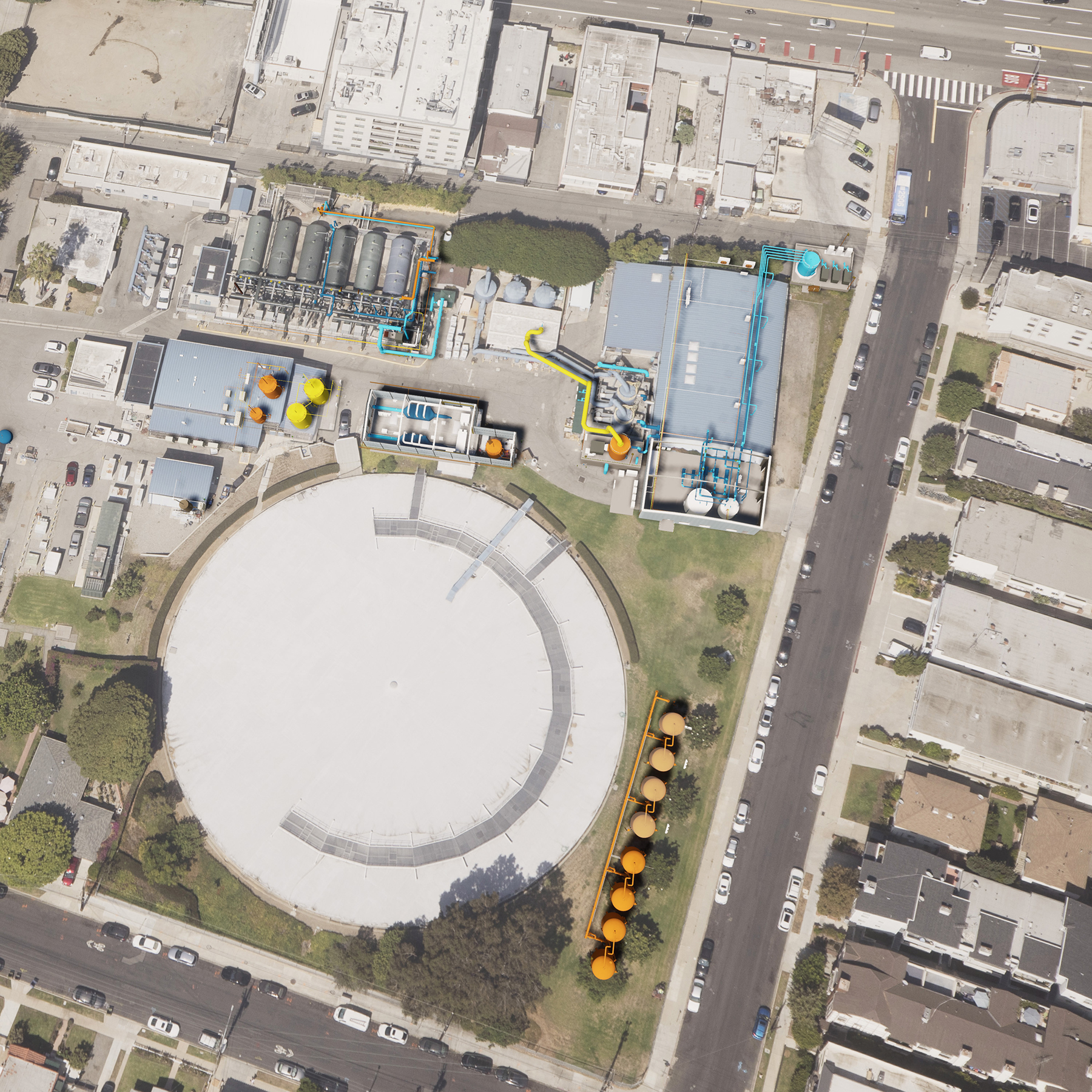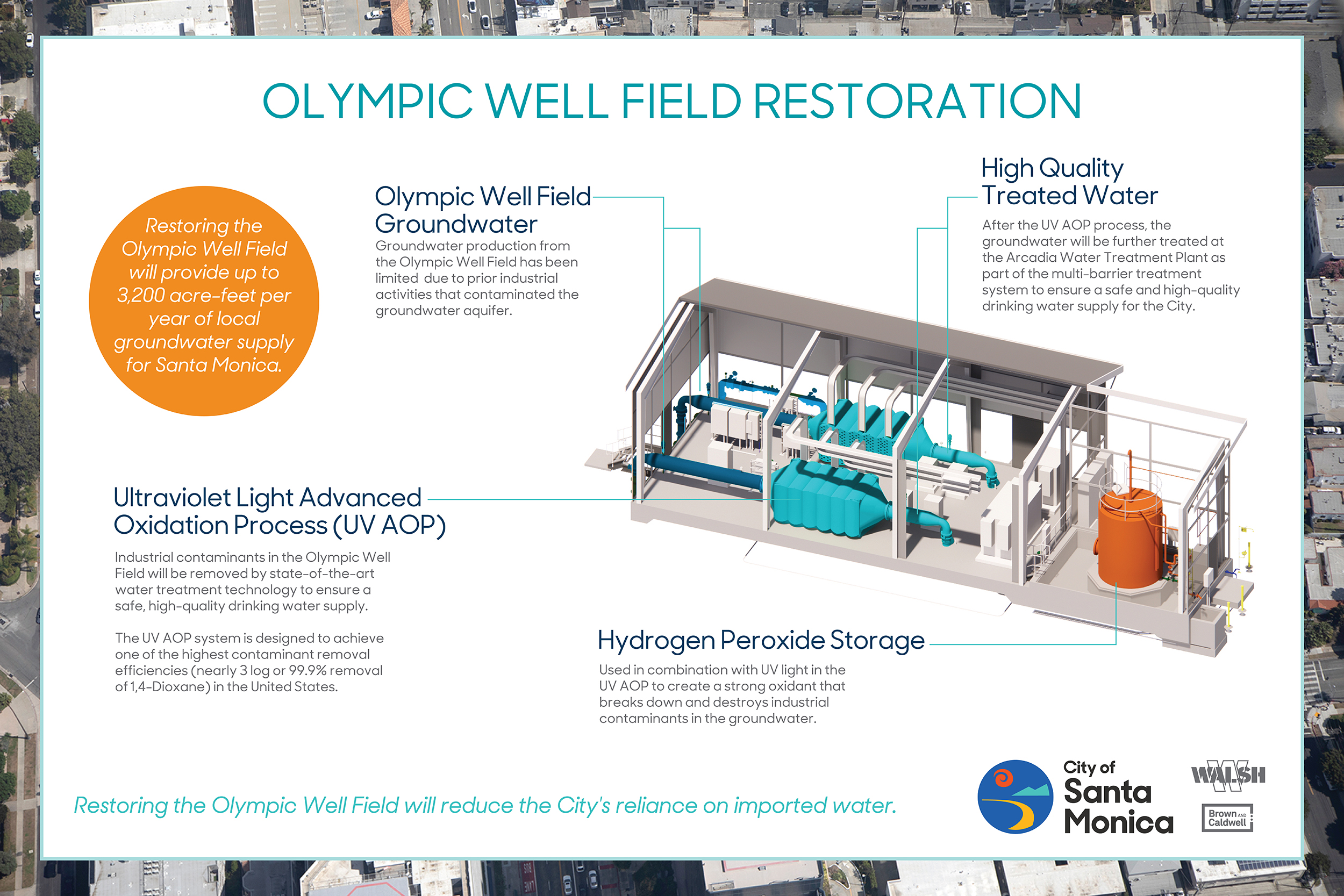By Jay Landers
As part of efforts to reduce its dependence on imported water supplies, the beachfront city of Santa Monica, California, is moving forward with plans to maximize its use of local groundwater sources. In January, construction began on a $72 million project to add and expand treatment facilities that will enable Santa Monica full use of a key local well field that was contaminated by past industrial activities. Among its noteworthy features, the project will entail the first municipal use of flow-reversal reverse-osmosis technology in the United States.
1% in 2023
Overall, Santa Monica’s 93,000 residents and 2,700 industrial customers require approximately 9 mgd of drinking water on average, says Sunny Wang, P.E., the water resources manager for the city of Santa Monica. The city has long relied on imported water provided by the Metropolitan Water District of Southern California to supplement its local groundwater supplies.
However, Santa Monica has worked in recent years to reduce its reliance on imported water. In 2011, the city’s water supply consisted of 48% imported water, 51% local groundwater, and 1% alternative water sources, Wang says. Since the city implemented conservation measures in 2017 in response to drought conditions, imported water has constituted about 29% of Santa Monica’s water supply.
But more remains to be done. “We hope to reduce that imported water piece down to 1% in 2023,” Wang says. Achieving this goal will require additional conservation efforts, heavier reliance on alternative water supplies, and greater use of local groundwater sources.
Key step
Regaining full use of its Olympic Well Field is a key step in Santa Monica’s efforts to become more self-sufficient in terms of its water supply. As a result of industrial activity decades ago, the well field is contaminated with chemicals commonly found in solvents: 1,4-dioxane, trichloroethylene, and tetrachloroethylene. For this reason, the city currently operates the well field at limited capacity to ensure that contaminants in the groundwater do not overwhelm the treatment capabilities of its Arcadia Water Treatment Plant.
With the existing system, the Arcadia WTP treats groundwater by means of greensand filtration, reverse osmosis, decarbonization, and disinfection. Treated water then undergoes air stripping in the city’s finished water reservoir to remove any residual volatile organic compounds.
Today, the facility accepts about 10 mgd and produces 8 mgd of finished drinking water.
The ongoing upgrade of the Arcadia WTP will enable it to take in approximately 13 mgd and produce 12 mgd of potable water.
To enable the Arcadia WTP to accept more groundwater from the Olympic Well Field, a new advanced water treatment facility is being constructed on the site of the WTP to treat the groundwater. “We are constructing a new plant within the treatment plant,” says Adam Zacheis, P.E., a senior project manager for Brown and Caldwell, which together with Walsh Construction is delivering the project by means of a progressive design-build approach.
Removing the contaminants
To remove the industrial contaminants from the groundwater, the new facility will employ greensand filtration to remove iron and manganese, followed by a method that combines ultraviolet light with advanced oxidation, using hydrogen peroxide as the oxidant. “That’s how we mineralize those contaminants in the water to produce a clean water stream,” Zacheis says.

Downstream of the ultraviolet advanced oxidation process, pressure filters containing granular activated carbon will remove residual hydrogen peroxide from the water. Groundwater cleansed in this manner then will be added to the RO feed tank and mixed with the water that is undergoing treatment as part of the main treatment process at the Arcadia WTP.
As things stand, Santa Monica is only able to pump and treat approximately one-third of the available supply from the Olympic Well Field, Wang says. “We’re only producing about 1 mgd instead of the potential 3 mgd from the well field,” he says. Once the new ultraviolet advanced oxidation process is in operation, “we’ll be able to treat the full 3 mgd and remove (the contamination) completely.”
RO retrofit
Upgrades to the Arcadia WTP are designed to improve treatment efficiency and increase overall production. Chief among these improvements is a planned retrofit of the RO system’s four trains to include flow-reversal RO technology, a process that has been used before only in Singapore, Wang says. “It will be the first installation in the United States.”
Flow-reversal RO technology is designed to prevent the buildup of scale on RO membranes, a problem that decreases the treatment efficiency of membranes. “The system works by periodically reversing flow,” Zacheis says. In this way, minerals in the feed stream are prevented from precipitating onto the membranes. This approach “allows you to run an RO system at a higher recovery that what is typically found in the industry,” Zacheis says.
Currently, the RO membranes at the Arcadia WTP achieve recovery rates on the order of 82% to 83%, Zacheis says.
“With the flow-reversal process, our target is to run at a minimum of 90% recovery,” Zacheis notes. The higher recovery rate will result in the production of more finished drinking water and a decrease in the volume of RO concentrate requiring disposal. “It has a pretty big impact on the amount of concentrate that you have to put down the sewer.”

Saving money, reducing energy use
Like much of the rest of Southern California, Santa Monica’s imported water supplies originate either from the Sierra Nevada or the Colorado River. With climate change raising questions about the long-term availability of these sources, the city’s efforts to diversify its water supplies make sense from a strategic standpoint.
And they also make sense from an economic point of view, Wang says. On average, the cost of water provided by the MWD has increased between 5% and 7% annually. By contrast, local water supply costs typically increase between 2.5% and 3% annually. Over the course of future decades, this difference in costs will result in considerable savings for Santa Monica, Wang says. “That’s why we’re investing (in local water supplies),” he says.
At the same time, switching to local water sources also reduces the city’s energy footprint as it relates to its water supply, Wang says. Unlike local sources, imported water must be pumped long distances and across mountain ranges, requiring large amounts of electricity. “Even though we’re using RO, which is a high energy-intensive process, it’s still lower energy consumption” compared with that involved with imported water, Wang says.
Construction challenges
Construction of the project is expected to be completed by summer 2023. Among the logistical challenges facing construction crews is a heavily constrained site offering little room for heavy equipment, says Shaun Jameson, the project manager for Walsh. Keeping the plant running while having to install new pipelines within the one road at the project site also will prove challenging, he says.
The process of retrofitting, rather than replacing, the existing RO systems also presents unique complications, Jameson says. “Typically, we procure a new RO system and install it fresh.” Having to retrofit the RO systems will require “a lot of coordination as far as the integration between the new and the old systems.”
Essentially, crews will have to “take one (RO system) down at a time, start it up, test it out, and make sure that it’s going to perform before we take the second, third, and fourth out of service,” Jameson says. Each of the four RO trains will be retrofitted in this fashion one at a time.
“The good thing is that once we get (each system) up online, we can run it as a traditional low-recovery RO system,” Jameson says. “Then once all four are retrofitted, that’s when we’ll bring them all up together to ultimately get to that 90% recovery.”



